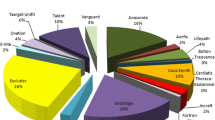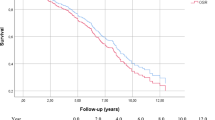Abstract
Objectives
The purpose of this single-institution study was to describe our 7-year intention-to-treat results, obtained with the use of endovascular techniques for the treatment of ruptured abdominal aortic aneurysms (rAAA).
Patients and Methods
From October 1998 until March 2005, a total of 28 patients were admitted or transferred to our department with an rAAA. They were all treated according to a management protocol of intention-to-treat with endovascular techniques. Twenty of the patients received endovascular treatment and the remaining 8 underwent an open surgery procedure.
Results
The mortality rate of the endovascularly treated patients was 40% (8 in 20), whereas of the 8 surgical patients 3 survived (mortality = 62.5%). The overall mortality rate of the 28 patients admitted with an rAAA was 46.4% (13 of 28 patients).
Conclusions
In our experience the intension-to-treat protocol for rAAA offered acceptable results in terms of mortality rates. Multi-center studies are necessary to establish the role of endovascular treatment in patients with rAAA.


Similar content being viewed by others

References
Calderwood R, Halka T, Haji-Michael P, et al. Ruptured abdominal aortic aneurysm. Is it possible to predict outcome? Int Angiol 2004;23:47
Heller JA, Weinberg A, Arons A, et al. Two decades of abdominal aortic aneurysm repair: have we made any progress? J Vasc Surg 2000;32:1091
Heikkinen M, Selenius JP, Auvinen O. Ruptured abdominal aortic aneurysm in a well-defined geographic area. J Vasc Surg 2002;35:291
Cassar K, Godden DJ, Duncan JL. Community mortality after ruptured abdominal aortic aneurysm is unrelated to the distance to the surgical center. Br J Surg 2001;88:1341
Semmens JB, Norman PE, Lawrence-Brown MM, et al. Influence of gender on outcome from ruptured abdominal aortic aneurysm. Br J Surg 2000;87:191
Choksy SA, Wilmink AB, Quick CR. Ruptured abdominal aortic aneurysm in the Huntingdon district: a 10-year experience. Ann R Coll Surg Engl 1999;81:27
Bengtsson H, Bergqvist D. Rupture abdominal aortic aneurysm: a population-based study. J Vasc Surg 1993;18:74
Previti FW, Onopchenko A, Glick B. The ruptured abdominal aortic aneurysm in a community hospital. A 5-year study. Am Surg 1992;58:499
AbuRahma AF, Woodruff BA, Lucente FC, et al. Factors affecting survival of patients with ruptured abdominal aortic aneurysm in a West Virginia community. Surg Gynecol Obstet 1991;172:377
Peppelenbosch N, Yilmaz N, van Marrewijk C, et al. Emergency treatment of acute symptomatic or ruptured abdominal aortic aneurysm. Outcome of a prospective intent-to-treat by EVAR protocol. Eur J Vasc Endovas Surg 2003;26:303
Gloviczki P, Pairolero PC, Mucha P Jr, et al. Ruptured abdominal aortic aneurysms: repair should not be denied. J Vasc Surg 1992;15:851–857
Cronenwett JL, Rutherford RB. Decision Making in Vascular Surgery, Philadelphia, W. B. Saunders Company, 2001
Castelli P, Caronno R, Piffaretti G, et al. Ruptured aortic aneurysm: endovascular treatment. Abdom Imaging 2005;30:263
Dalainas I, Nano G, Casana R, et al. Mid-term results after endovascular repair of abdominal aortic aneurysms: a four-year experience. Eur J Vasc Endovasc Surg 2004;27:319
Gerassimidis TS, Papazoglou KO, Kamparoudis AG, et al. Endovascular management of ruptured abdominal aortic aneurysms: 6-year experience from a Greek center. J Vasc Surg 2005;42:615–623
Yilmaz N, Peppelenbosch N, Cuypers PW, et al. Emergency treatment of symptomatic or ruptured abdominal aortic aneurysms: the role of endovascular repair. J Endovasc Ther 2002;24:449–457
van Sambeek MRHM, van Dijk LC, Hendriks JM, et al. Endovascular versus conventional open repair of acute abdominal aortic aneurysm: feasibility and preliminary results. J Endovasc Ther 2002;9:443–448
Kapma MR, Verhoeven EL, Tielliu IF, et al. Endovascular treatment of acute abdominal aortic aneurysm with a bifurcated stent graft. Eur J Vasc Endovasc Surg 2005;29:510–515
Author information
Authors and Affiliations
Corresponding author
Rights and permissions
About this article
Cite this article
Dalainas, I., Nano, G., Bianchi, P. et al. Endovascular Techniques for the Treatment of Ruptured Abdominal Aortic Aneurysms: 7-year Intention-to-treat Results. World J. Surg. 30, 1809–1814 (2006). https://doi.org/10.1007/s00268-005-0667-8
Published:
Issue Date:
DOI: https://doi.org/10.1007/s00268-005-0667-8



